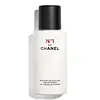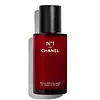What's inside
What's inside
 Key Ingredients
Key Ingredients

No key ingredients
 Benefits
Benefits

 Concerns
Concerns

 Ingredients Side-by-side
Ingredients Side-by-side

Camellia Japonica Flower Water
Skin ConditioningPropanediol
SolventGlycerin
HumectantWater
Skin ConditioningPentylene Glycol
Skin ConditioningSodium Citrate
BufferingSodium Polyacrylate
AbsorbentFaex
Skin ConditioningCoffea Arabica Seed Oil
MaskingCamellia Japonica Flower Extract
EmollientParfum
MaskingChlorphenesin
AntimicrobialCitric Acid
BufferingEthylhexyl Palmitate
EmollientCaprylyl Glycol
EmollientXanthan Gum
EmulsifyingSodium Hyaluronate
HumectantChondrus Crispus Powder
AbrasiveAdenosine
Skin ConditioningLactic Acid
BufferingSaccharide Isomerate
Humectant1,2-Hexanediol
Skin ConditioningPalmitoyl Tetrapeptide-7
Skin ConditioningCamellia Japonica Flower Water, Propanediol, Glycerin, Water, Pentylene Glycol, Sodium Citrate, Sodium Polyacrylate, Faex, Coffea Arabica Seed Oil, Camellia Japonica Flower Extract, Parfum, Chlorphenesin, Citric Acid, Ethylhexyl Palmitate, Caprylyl Glycol, Xanthan Gum, Sodium Hyaluronate, Chondrus Crispus Powder, Adenosine, Lactic Acid, Saccharide Isomerate, 1,2-Hexanediol, Palmitoyl Tetrapeptide-7
 Reviews
Reviews

Ingredients Explained
These ingredients are found in both products.
Ingredients higher up in an ingredient list are typically present in a larger amount.
1,2-Hexanediol is a synthetic liquid and another multi-functional powerhouse.
It is a:
- Humectant, drawing moisture into the skin
- Emollient, helping to soften skin
- Solvent, dispersing and stabilizing formulas
- Preservative booster, enhancing the antimicrobial activity of other preservatives
Camellia Japonica Flower Extract comes from the Japanese Camellia plant. This plant is native to East Asia and known as "Tsubaki" in Japanese.
Tsubaki flowers possess antioxidant and soothing properties. This flower has shown to be effective at fighting pollution damage by protecting your skin's fibroblasts. Your skin's fibroblasts help create collagen and collagen is responsible for youthful, plump skin.
This flower also contains many antioxidant enzymes. Antioxidants help fight free-radical molecules. Free-radical molecules are capable of damaging our cells and other genetic material. They may originate from sunlight, air pollution, or cigarette smoke. These free-radical molecules are unstable and are often looking for missing electrons. This instability causes free-radicals to damage our cells. Antioxidants help stabilize free-radicals by donating extra electrons.
Thus, Camellia Japonica Flower Extract may help reduce the signs of aging.
Learn more about Camellia Japonica Flower ExtractCaprylyl Glycol is a humectant and emollient, meaning it attracts and preserves moisture.
It is a common ingredient in many products, especially those designed to hydrate skin. The primary benefits are retaining moisture, skin softening, and promoting a healthy skin barrier.
Though Caprylyl Glycol is an alcohol derived from fatty acids, it is not the kind that can dry out skin.
This ingredient is also used as a preservative to extend the life of products. It has slight antimicrobial properties.
Learn more about Caprylyl GlycolParfum is a catch-all term for an ingredient or more that is used to give a scent to products.
Also called "fragrance", this ingredient can be a blend of hundreds of chemicals or plant oils. This means every product with "fragrance" or "parfum" in the ingredients list is a different mixture.
For instance, Habanolide is a proprietary trade name for a specific aroma chemical. When used as a fragrance ingredient in cosmetics, most aroma chemicals fall under the broad labeling category of “FRAGRANCE” or “PARFUM” according to EU and US regulations.
The term 'parfum' or 'fragrance' is not regulated in many countries. In many cases, it is up to the brand to define this term.
For instance, many brands choose to label themselves as "fragrance-free" because they are not using synthetic fragrances. However, their products may still contain ingredients such as essential oils that are considered a fragrance by INCI standards.
One example is Calendula flower extract. Calendula is an essential oil that still imparts a scent or 'fragrance'.
Depending on the blend, the ingredients in the mixture can cause allergies and sensitivities on the skin. Some ingredients that are known EU allergens include linalool and citronellol.
Parfum can also be used to mask or cover an unpleasant scent.
The bottom line is: not all fragrances/parfum/ingredients are created equally. If you are worried about fragrances, we recommend taking a closer look at an ingredient. And of course, we always recommend speaking with a professional.
Learn more about ParfumPropanediol is an all-star ingredient. It softens, hydrates, and smooths the skin.
It’s often used to:
Propanediol is not likely to cause sensitivity and considered safe to use. It is derived from corn or petroleum with a clear color and no scent.
Learn more about PropanediolWater. It's the most common cosmetic ingredient of all. You'll usually see it at the top of ingredient lists, meaning that it makes up the largest part of the product.
So why is it so popular? Water most often acts as a solvent - this means that it helps dissolve other ingredients into the formulation.
You'll also recognize water as that liquid we all need to stay alive. If you see this, drink a glass of water. Stay hydrated!
Learn more about WaterXanthan gum is used as a stabilizer and thickener within cosmetic products. It helps give products a sticky, thick feeling - preventing them from being too runny.
On the technical side of things, xanthan gum is a polysaccharide - a combination consisting of multiple sugar molecules bonded together.
Xanthan gum is a pretty common and great ingredient. It is a natural, non-toxic, non-irritating ingredient that is also commonly used in food products.
Learn more about Xanthan Gum